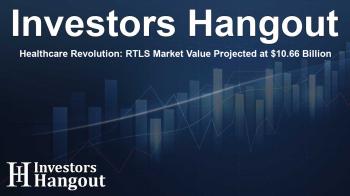Healthcare Revolution: RTLS Market Value Projected at $10.66 Billion

Transforming Healthcare with Real-Time Location Systems
The real-time location systems (RTLS) market in healthcare is making waves as it is set to grow significantly in the coming years. Driven by the vital need for patient tracking, asset management, and workflow optimization, the growth of this market presents exciting opportunities for healthcare facilities to enhance patient care and safety.
Market Growth and Projections
According to recent analyses, the RTLS market for healthcare is valued at approximately US$3.27 billion. Analysts expect this figure to rise dramatically, reaching up to US$10.66 billion by 2031. This represents an impressive compound annual growth rate (CAGR) of 18.6% from 2025 until 2031. Such growth is largely fueled by a heightened demand for advanced safety measures and efficient asset tracking within healthcare contexts.
Patient Safety and Efficiency
One of the core reasons behind the surge in RTLS adoption is the commitment to enhancing patient safety. RTLS employs advanced analytics, powered by artificial intelligence and the integration of IoT sensors, to form an accurate and real-time location solution essential for modern healthcare environments.
Regulatory Compliance and Technological Advances
The increasing emphasis on regulatory compliance also serves as a key driver for RTLS adoption. By ensuring that healthcare facilities have an accurate audit trail for medical equipment and supplies, RTLS systems assist organizations in complying with various healthcare standards. This proactive approach to patient safety remains vital as regulations evolve.
The Role of ePHI in Security Enhancements
Furthermore, as modifications to the Health Insurance Portability and Accountability Act (HIPAA) become necessary, enhancing the security of electronic protected health information (ePHI) is paramount. These updates reinforce the need for healthcare organizations to implement secure tracking systems that protect patient data integrity and confidentiality.
Responding to the Rise in Chronic Conditions
The escalation of chronic diseases such as diabetes and respiratory conditions is shining a light on the necessity for continuous and real-time monitoring in healthcare. RTLS facilitates a transformative approach to patient care through the Internet of Medical Things (IoMT), allowing for localized patient monitoring. This development enhances the collection of real-time data and facilitates timely healthcare interventions.
Innovative Pilot Studies
An interesting example comes from NHS England, which recently piloted a clinical innovation project utilizing RTLS technology. This initiative tracked over 450 medical devices, effectively mitigating clinical incidents and improving the organization of care across several treatment centers.
Global Insights and Market Dynamics
The regional dynamics of the RTLS market reveal interesting trends, especially in the Asia Pacific, which currently holds a significant share. The rapid growth of healthcare infrastructure and technological adoption is contributing to its dominance in the RTLS landscape. North America and Europe are not far behind, as they adopt healthcare technologies effectively.
Key Market Segments and Healthcare Applications
The RTLS market segmentation indicates a comprehensive framework. The predominant categories include hardware, software, and services, with a marked preference for software, which improves operational efficiencies in high-volume healthcare facilities.
Competitive Landscape and Innovations
Several key players are shaping the RTLS market, including innovative companies that are at the forefront of technological advancement. Zebra Technologies, AiRISTA Flow, and Impinj are just a few names leading the way with groundbreaking solutions that improve patient tracking, asset management, and infection control strategies.
Future Directions and Strategic Growth
As healthcare providers increasingly invest in RTLS technologies, the focus on improving patient care quality is unmistakable. Advancements involving AI and IoT are set to revolutionize operational performance, making RTLS not just a tool, but a foundational component in modern healthcare infrastructure.
Frequently Asked Questions
What is the projected growth for the healthcare RTLS market?
The RTLS market for healthcare is projected to reach US$10.66 billion by 2031, reflecting a CAGR of 18.6% from 2025.
Why is patient safety emphasized in RTLS adoption?
RTLS enhances patient safety by providing real-time tracking, which ensures effective monitoring of patients and medical assets.
How do regulatory changes impact RTLS?
Regulatory changes demand enhanced security measures for ePHI, motivating healthcare facilities to adopt RTLS systems for better compliance.
What role does AI play in RTLS technology?
AI powers analytics for RTLS, enabling precise and flexible location tracking solutions crucial for optimizing healthcare operations.
What are the main segments of the RTLS market?
The RTLS market is segmented into hardware, software, and services, with software being the most dominant segment due to its efficiency in healthcare environments.
About The Author
Contact Evelyn Baker privately here. Or send an email with ATTN: Evelyn Baker as the subject to contact@investorshangout.com.
About Investors Hangout
Investors Hangout is a leading online stock forum for financial discussion and learning, offering a wide range of free tools and resources. It draws in traders of all levels, who exchange market knowledge, investigate trading tactics, and keep an eye on industry developments in real time. Featuring financial articles, stock message boards, quotes, charts, company profiles, and live news updates. Through cooperative learning and a wealth of informational resources, it helps users from novices creating their first portfolios to experts honing their techniques. Join Investors Hangout today: https://investorshangout.com/
The content of this article is based on factual, publicly available information and does not represent legal, financial, or investment advice. Investors Hangout does not offer financial advice, and the author is not a licensed financial advisor. Consult a qualified advisor before making any financial or investment decisions based on this article. This article should not be considered advice to purchase, sell, or hold any securities or other investments. If any of the material provided here is inaccurate, please contact us for corrections.

